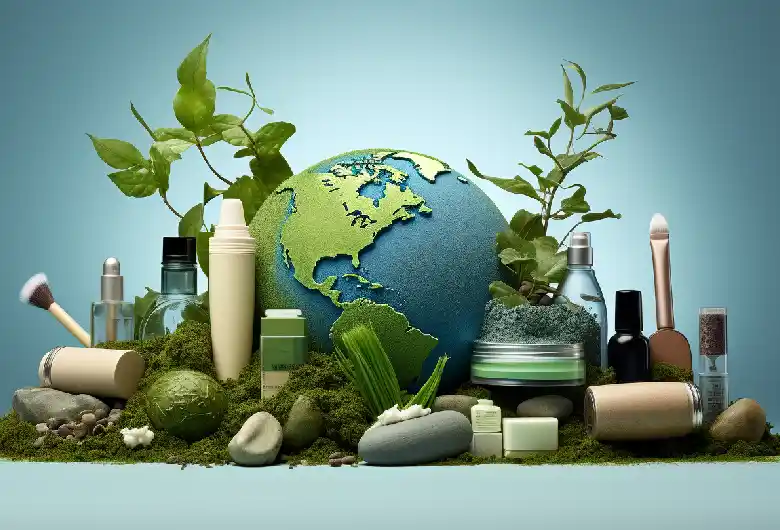Historically, the beauty industry has been known for harmful chemicals and contributions to climate change. But it’s no longer the case that your beauty regime needs to be damaging to the environment. Here are six ways to make your beauty buying more eco-friendly.
Thankfully, we’ve become more aware of climate change and the environmental cost of our daily purchases and choices. And increasingly, we’re seeing people trying to make changes. People are upcycling and recycling all sorts of items, from fashion to furniture. Others are going zero emission by changing to EVs. Many more are making conscious decisions to buy from eco-friendly brands.

1. Choose Sustainable Packaging: Packaging significantly contributes to cosmetic-related waste. Opt for products that come in sustainable packaging, such as paper, card, glass, metal, or recycled materials. Specifically, look for brands that prioritize eco-friendly alternatives and aim to reduce their use of single-use plastics. You can significantly decrease your ecological impact by choosing products with minimal packaging or packaging made from recyclable materials.
The prevalence of single-use products, such as sheet masks, wipes, and sample-sized items, contributes to environmental pollution. These products often end up in landfills, and their production involves the use of resources that may not be sustainable.
2. Support Cruelty-Free Brands: Many cosmetics brands still engage in animal testing, which raises ethical concerns and has environmental implications. Choose products from cruelty-free brands that do not test their products on animals. Supporting these companies promotes the honest treatment of animals and encourages a shift toward more sustainable and humane practices within the beauty industry.
3. Opt for Refillable Products: Refillable cosmetics are gaining popularity as a sustainable alternative to traditional single-use products. Look for brands that offer refillable options for items like foundation, lipstick, and eyeshadow. By choosing refillable products, you reduce the amount of packaging that ends up in landfills, and you can often save money in the long run.
Glitters and microplastics used in some beauty products, such as nail polish and certain cosmetics, are often non-biodegradable. These particles can end up in oceans and waterways, posing risks to marine life and ecosystems
4. Prioritise Natural and Organic Ingredients: Conventional cosmetics often contain synthetic ingredients that may harm your skin and the environment. Opt for products made with natural and organic ingredients that are sustainably sourced. These products are better for your skin and contribute to a healthier planet by reducing the demand for environmentally damaging farming practices and chemical production.
5. Mindful Consumption: Consider whether you need a new product or can use what you already have. Conscious consumption is a crucial aspect of sustainable living. By avoiding unnecessary purchases and using products until they are fully depleted, you reduce the demand for new items and minimize your overall environmental impact.
Incorporate water-saving practices into your beauty routine. Turn off the tap while applying cleanser or shampoo, and consider using a facial mist instead of rinsing your face for a quick refresh. Water is a precious resource, and minimizing its usage in your beauty routine contributes to overall sustainability.
6. DIY Beauty: For those who enjoy a hands-on approach, consider making your cosmetics home. DIY beauty products allow you to control the ingredients, reduce packaging waste, and tailor products to your specific needs. Numerous resources are available online with recipes for homemade cleansers, masks, and other beauty essentials that are eco-friendly and customizable to your preferences.
Consider the energy consumption of beauty tools. Turn off hairdryers, straighteners, and other devices when not in use. Additionally, explore energy-efficient alternatives, such as low-energy LED mirrors. By being mindful of energy usage in your beauty routine, you contribute to a more sustainable and eco-friendly lifestyle.
Trivia
The beauty industry is a significant contributor to plastic waste. According to a report by the Ellen MacArthur Foundation, it was estimated that by 2050, there could be more plastic in the ocean than fish by weight. Packaging, much of which is single-use, plays a substantial role in this issue. (1)
The production and transportation of beauty products contribute to greenhouse gas emissions. While specific figures can vary, a study published in the Journal of Industrial Ecology estimated that the beauty and personal care sector’s carbon footprint accounted for around 2% of the world’s total greenhouse gas emissions.
Many beauty companies are actively working to reduce their carbon footprint. According to the Carbon Disclosure Project (CDP), some leading beauty and personal care companies have committed to ambitious sustainability goals, including achieving carbon neutrality, using renewable energy, and adopting circular economy principles.
Takeaway
Making your cosmetics purchases more eco-friendly and sustainable doesn’t mean sacrificing beauty or quality. By being conscious of your choices and supporting brands that prioritize sustainability, you can contribute to a more environmentally friendly beauty industry. Whether opting for sustainable packaging, choosing cruelty-free products, or embracing DIY alternatives, every small change in your cosmetic routine can significantly impact the planet. And if we all make small changes, these will soon add to significant impact.
